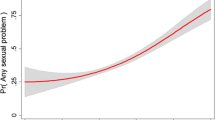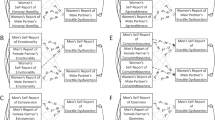Abstract
The prevalence of erectile difficulties (ED) and problems with rapid ejaculation (RE) were studied in a convenience sample of gay men (n = 1379) and an age-matched sample of heterosexual men (n = 1558). ED was reported more frequently by gay men and RE more frequently by heterosexual men. The heterosexual men were more likely to be in exclusive relationships and those in a current relationship (exclusive or non-exclusive) were more likely to report ED than those not in a relationship. Heterosexual men in an exclusive relationship were more likely to report RE than the rest. These associations were not found in the gay sample. The following personality traits were assessed as possible predictors of ED and RE: sexual inhibition proneness (SIS1 and SIS2), sexual excitation proneness, impact of mood on sexuality, and trait measures of depression and anxiety. Age and SIS1 (inhibition due to threat of performance failure) were strong predictors of ED in both gay and heterosexual men. Gay men scored higher on SIS1 whether or not they reported ED, consistent with greater concerns about performance failure in gay men. Anxiety was predictive of RE, but only in the heterosexual men. If replicated in other samples, these differences may reflect a greater importance of erectile function in the sexual lives of gay men and greater importance of ejaculatory control in heterosexual relationships.
Similar content being viewed by others

References
Angst, J. (1998). Sexual problems in healthy and depressed persons. International Clinical Psychopharmacology, 13(Suppl. 6), S1–S4.
Araujo, A. B., Durante, R., Feldman, H. A., Goldstein, I., & McKinlay, J. B. (1998). The relationship between depressive symptoms and male erectile dysfunction: Cross-sectional results from the Massachusetts Male Aging Study. Psychosomatic Medicine, 60, 458–465.
Bancroft, J. (1999). Central inhibition of sexual response in the male: A theoretical perspective. Neuroscience and Biobehavioral Reviews, 23, 763–784.
Bancroft, J., Carnes, L., Janssen, E., & Long, J. S. (2005). Unprotected anal intercourse in HIV-positive and HIV-negative gay men: The relevance of sexual arousability, mood, sensation seeking, and erectile problems. Archives of Sexual Behavior, 34, 299–305.
Bancroft, J., Herbenick, D., Barnes, T., Hallam-Jones, R., Wylie, K., Janssen, E., et al. (in press). The relevance of the Dual Control Model to male sexual dysfunction: The Kinsey Institute/BASRT Collaborative Project. Sexual & Relationship Therapy.
Bancroft, J., & Janssen, E. (2000). The dual control model of male sexual response: A theoretical approach to centrally mediated erectile dysfunction. Neuroscience and Biobehavioral Reviews, 24, 571–579.
Bancroft, J., & Janssen, E. (2001) Psychogenic erectile dysfunction in the era of pharmacotherapy: A theoretical approach. In J. Mulcahy (Ed.), Male sexual function: A guide to clinical management (pp. 79–89). Totowa, NJ: Humana Press.
Bancroft, J., Janssen, E., Carnes, L., Goodrich, D., Strong, D., & Long, J. S. (2004). Sexual activity and risk taking in young heterosexual men: The relevance of sexual arousability, mood, and sensation seeking. Journal of Sex Research, 41, 181–192.
Bancroft, J., Janssen, E., Strong, D., Carnes, L., & Long, J. S. (2003). Sexual risk taking in gay men: The relevance of sexual arousability, mood, and sensation seeking. Archives of Sexual Behavior, 32, 555–572.
Bancroft, J., Janssen, E., Strong, D., & Vukadinovic, Z. (2003). The relation between mood and sexuality in gay men. Archives of Sexual Behavior, 32, 231–242.
Bancroft, J., Janssen, E., Strong, D., Vukadinovic, Z., & Long, J. S. (2003). The relation between mood and sexuality in heterosexual men. Archives of Sexual Behavior, 32, 217–230.
Bancroft, J., Loftus, J., & Long, J. S. (2003). Distress about sex: A national survey of women in heterosexual relationships. Archives of Sexual Behavior, 32, 193–208.
Beck, A. T. (1967). Depression: Clinical, experimental and theoretical aspects. London: Staples Press.
Beck, A. T., Steer, R. A., & Garbin, M. G. (1988). Psychometric properties of the Beck Depression Inventory: Twenty-five years of evaluation. Clinical Psychology Review, 8, 77–100.
Brant, R. (1990). Assessing proportionality in the proportional odds model for ordinal logistic regression. Biometrics, 46, 1171–1178.
Byers, E. S., & Grenier, G. (2003). Premature or rapid ejaculation: Heterosexual couples’ perceptions of men’s ejaculatory behavior. Archives of Sexual Behavior, 32, 261–270.
Byrne, D., & Schulte, L. (1990). Personality dispositions as mediators of sexual responses. Annual Review of Sex Research, 1, 93–117.
Cooper, A. J. (1968). Hostility and male potency disorders. Comprehensive Psychiatry, 6, 621–626.
Cooper, A. J., Cernovsky, Z. Z., & Colussi, K. (1993). Some clinical and psychometric characteristics of primary and secondary premature ejaculators. Journal of Sex & Marital Therapy, 19, 276–288.
Costa, P. T., Fagan, P. J., Piedmont, R. L., Ponticas, Y., & Wise, T. N. (1992). The five-factor model of personality and sexual functioning in outpatient men and women. Psychiatric Medicine, 2, 199–215.
Eysenck, H. J. (1976). Sex and personality. London: Open Books.
Fergusson, D. M., Horwood, L. J., & Beautrais, A. L. (1999). Is sexual orientation related to mental health problems and suicidality in young people? Archives of General Psychiatry, 56, 876–880.
Figueira, I., Possidente, E., Marques, C., & Hayes, K. (2001). Sexual dysfunction: A neglected complication of panic disorder and social phobia. Archives of Sexual Behavior, 30, 369–377.
Fisher, W. A., Byrne, D., White, L. A., & Kelley, K. (1988). Erotophobia-erotophilia as a dimension of personality. Journal of Sex Research, 25, 123–151.
Gilman, S. E., Cochran, S. D., Mays, V. M., Hughes, M., Ostrow, D., & Kessler, R. C. (2001). Risk of psychiatric disorders among individuals reporting same-sex sexual partners in the National Comorbidity Survey. American Journal of Public Health, 91, 933–939.
Herrell, R., Goldberg, J., True, W. R., Ramakrishnan, V., Lyons, M., Eisen, S., et al. (1999). Sexual orientation and suicidality: A co-twin control study in adult men. Archives of General Psychiatry, 56, 867–874.
Hosmer, D. W., & Lemeshow, S. (2000). Applied logistic regression (2nd ed.). New York: Wiley.
Janssen, E., Vorst, H., Finn, P., & Bancroft, J. (2002a). The Sexual Inhibition (SIS) and Sexual Excitation (SES) Scales: I. Measuring sexual inhibition and excitation proneness in men. Journal of Sex Research, 39, 114–126.
Janssen, E., Vorst, H., Finn, P., & Bancroft, J. (2002b). The Sexual Inhibition (SIS) and Sexual Excitation (SES) Scales: II. Predicting psychophysiological response patterns. The Journal of Sex Research, 39, 127–132.
Laumann, E. O., Paik, A., & Rosen, R. C. (1999). Sexual dysfunction in the United States: Prevalence and predictors. Journal of the American Medical Association, 281, 537–544.
Long, J. S. (1997). Regression models for categorical and limited dependent variables. Thousand Oaks, CA: Sage Press.
Mills, T. C., Paul, J., Stall, R., Pollack, L., Canchola, J., Changh, Y. J., et al. (2004). Distress and depression in men who have sex with men: The Urban Men’s Health Study. American Journal of Psychiatry, 16, 278–285.
Remafedi, G., French, S., Story, M., Resnick, M. D., & Blum, R. (1998). The relationship between suicide risk and sexual orientation: Results of a population-based study. American Journal of Public Health, 88, 57–60.
Rowland, D. L., de Gouvea Brazao, C., Strassberg, D. A., & Slob, A. K. (2000). Ejaculatory latency and control in men with premature ejaculation: A detailed analysis across sexual activities using multiple sources of information. Journal of Psychosomatic Research, 48, 69–77.
Rowland, D. L., Tai, W., & Brummett, K. (in press). In E. Janssen (Ed.), The psychophysiology of sex. Bloomington, IN: Indiana University Press.
Sandfort, T. G. M., de Graff, R., Bijl, R. V., & Schnabel, P. (2001). Same-sex sexual behavior and psychiatric disorders. Archives of General Psychiatry, 58, 85–91.
Sandfort, T. G. M., & de Keizer, M. (2001). Sexual problems in gay men: An overview of empirical research. Annual Review of Sex Research, 12, 93–120.
Shires, A., & Miller, D. (1998). A preliminary study comparing psychological factors associated with erectile dysfunction in heterosexual and homosexual men. Sexual and Marital Therapy, 13, 37–49.
Simons, J. S., & Carey, M. P. (2001). Prevalence of sexual dysfunctions: Results from a decade of research. Archives Sexual Behavior, 30, 177–219.
Simpson, J. A., & Gangestad, S. W. (1991). Individual differences in sociosexuality: Evidence for convergent and discriminant validity. Journal of Personality and Social Psychology, 60, 870–883.
Slater, E. (1945). Neurosis and sexuality. Journal of Neurology, Neurosurgery and Psychiatry, 8, 12–14.
Spielberger, C. D., Gorsuch, R. L., & Lushene, R. E. (1970). STAI manual for the State Trait Anxiety Inventory. Palo Alto, CA: Consulting Psychologists Press.
Strassberg, D. S., Mahoney, J. M., Schaugaard, M., & Hale, V. (1990). The role of anxiety in premature ejaculation: A psychophysiological model. Archives of Sexual Behavior, 3, 251–257.
Ware, M. R., Emmanuel, N. P., Johnson, M. R., Brawman-Mintzer, O., Knapp, R., Crawford-Harrison, M., et al. (1996). Self-reported sexual dysfunctions in anxiety disorder patients. Psychopharmacology Bulletin, 32, 530.
Zemore, R., Fischer, D. G., Garratt, L. S., & Miller, C. (1990). The depression proneness rating scale: Reliability, validity, and factor structure. Current Psychology: Research & Reviews, 9, 255–263.
Author information
Authors and Affiliations
Corresponding author
Rights and permissions
About this article
Cite this article
Bancroft, J., Carnes, L., Janssen, E. et al. Erectile and Ejaculatory Problems in Gay and Heterosexual Men. Arch Sex Behav 34, 285–297 (2005). https://doi.org/10.1007/s10508-005-3117-7
Received:
Revised:
Accepted:
Issue Date:
DOI: https://doi.org/10.1007/s10508-005-3117-7



